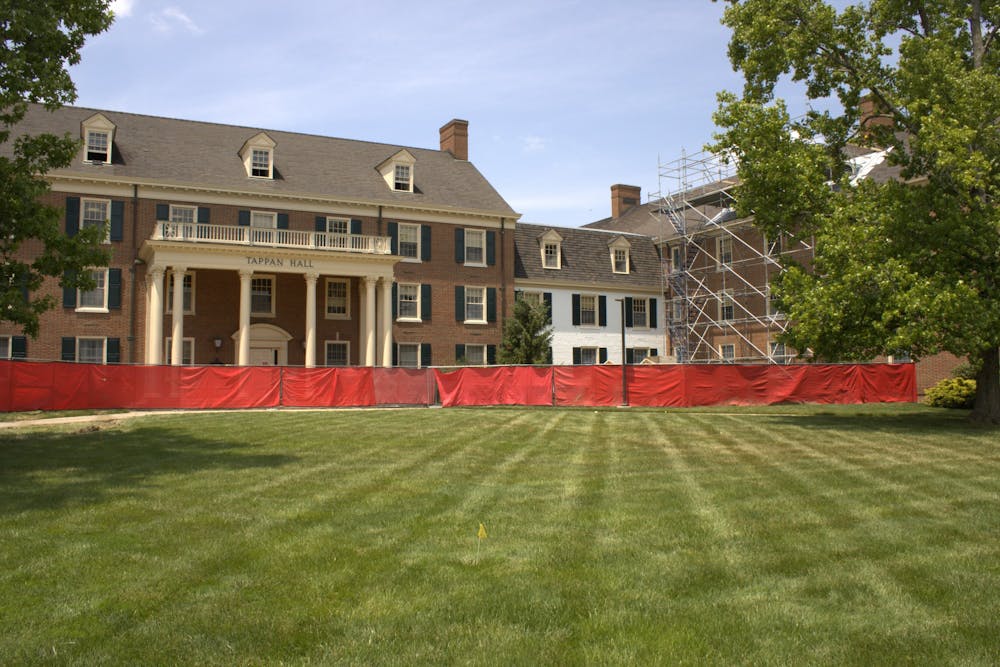Miami University students moving into residence halls on south quad can breathe easy after this summer’s building updates.
This summer, fresh air systems are being installed in rooms in Tappan Hall. This is part of a multi-year project to address air quality issues within Emerson, Morris and Tappan, all residential halls on south quad. Emerson and Morris will also eventually update to fresh air systems.
Rob Abowitz, associate director of the Office of Residence Life (ORL), said proper air ventilation did not become a concern until other major renovations that required gutting the buildings had been completed.
“There was just not [enough] air moving through the building[s],” Abowitz said. “[Physical facilities] went back into the buildings that had been renovated … new drywall, new HVAC, new everything and put air flow shafts through all of these residence hall rooms.”
Robert Bell, director of planning, architecture and engineering at Miami, said prior to these renovations, the ventilation systems in the restrooms was enough to bring fresh air into the buildings because the system pulled all the air out of the building and separated it. In addition, there was an air exchange from the opening and closing of the doors.
Bell said the annual summer work on Emerson, Morris and Tappan is scheduled to be finished in 2025 or 2026. Based on last year’s planning budget, the renovations are estimated to cost roughly $17.5 million.
Campus Services, which runs as an auxiliary and operates the residence halls, pays for the renovations, but it also must generate its own funding.
“This is all paid for through the room and board that [students] pay,” Bell said. “It’s all separate from the general fees and tuition and that part of the [university’s] budget.”
The remaining buildings that need fresh air systems installed are Havighurst and Peabody on Western campus.
Not every building is lucky enough to be revamped, though. McKee and Thomson, two residential buildings on Western campus, are not among Campus Services’s renovation plans for fresh air systems. Bell said McKee will likely be reused as an administrative building. Thomson, however, will be torn down to free up more space for a new residence hall.
Thomson’s eventual demolition will also destroy the only remaining building with a full kitchen in each corridor. Although this may seem trivial, Abowitz commented that Thomson has always had a close community because “it’s an example of how the design and architecture of the building facilitated community.”
“The answer to the question, ‘How was your first year?’ is significantly less about whether your building is renovated than it is about building community, making friends, getting connected, having a positive experience academically [and] having a sense of belonging,” Abowitz said.
Enjoy what you're reading?
Signup for our newsletter
How Residence Life makes decisions
Each fall and spring semester, all students living on campus receive the Assessment of Living and Learning (ALL) survey from the Office of Residence Life (ORL).
The survey covers the students’ residential experiences, including questions on Living and Learning Communities (LLCs), roommates, communication with resident assistants (RA) and resident directors (RD), etc.
Of the seven to eight thousand students who live on campus, roughly 25 to 30% respond to the ALL survey.
Erik Sorensen, assistant director of the ORL, said the survey is around 50 questions and takes about 10 minutes to complete.
Most of the questions use the Likert scale, allowing the student to indicate how much they agree or disagree with the statement provided. Depending on the response, the student may be prompted with an open-ended question, letting them explain their answer in more detail.
“We want to offer that opportunity [to answer open-ended questions] so [students] can really say, ‘Here’s what I’m thinking,’” Sorensen said.
The RD for each community also receives a report from ORL that includes survey responses. They are then asked to make goals for the next semester to help address concerns students raised in the survey.
“It gives us a sense of the climate and culture in the buildings,” Sorenson said. “Even if most students are having a positive experience, I can still look at the ones who aren’t and say, ‘Well, what did they tell us?’”
He said that he takes the time to read through every response from every student.
“I don’t want it to go to waste because I appreciate that the students have taken the time to do that and share that with us,” Sorensen said.




